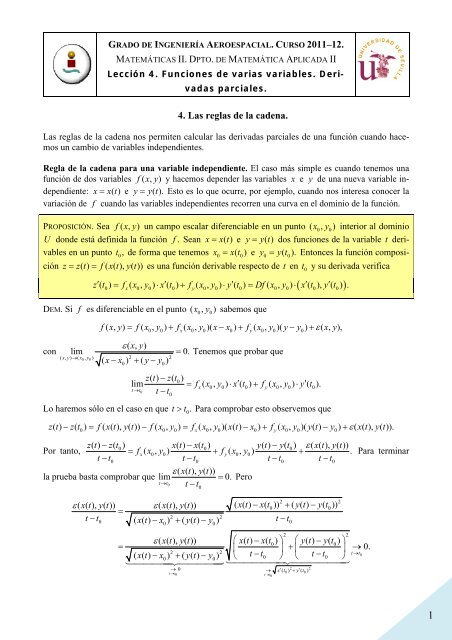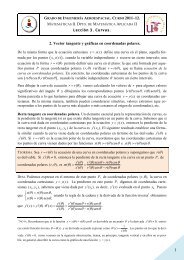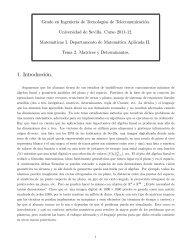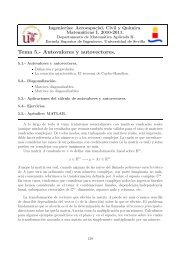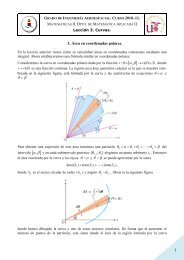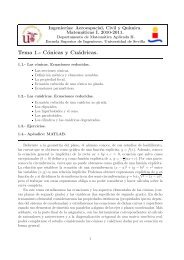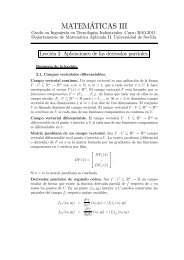Leccion 4. 4. Las reglas de la cadena - Matemática Aplicada II
Leccion 4. 4. Las reglas de la cadena - Matemática Aplicada II
Leccion 4. 4. Las reglas de la cadena - Matemática Aplicada II
You also want an ePaper? Increase the reach of your titles
YUMPU automatically turns print PDFs into web optimized ePapers that Google loves.
GRADO DE INGENIERÍA AEROESPACIAL. CURSO 2011–12.<br />
MATEMÁTICAS <strong>II</strong>. DPTO. DE MATEMÁTICA APLICADA <strong>II</strong><br />
Lección <strong>4.</strong> Funciones <strong>de</strong> varias variables. Derivadas<br />
parciales.<br />
<strong>4.</strong> <strong>Las</strong> <strong>reg<strong>la</strong>s</strong> <strong>de</strong> <strong>la</strong> ca<strong>de</strong>na.<br />
<strong>Las</strong> <strong>reg<strong>la</strong>s</strong> <strong>de</strong> <strong>la</strong> ca<strong>de</strong>na nos permiten calcu<strong>la</strong>r <strong>la</strong>s <strong>de</strong>rivadas parciales <strong>de</strong> una función cuando hacemos<br />
un cambio <strong>de</strong> variables in<strong>de</strong>pendientes.<br />
Reg<strong>la</strong> <strong>de</strong> <strong>la</strong> ca<strong>de</strong>na para una variable in<strong>de</strong>pendiente. El caso más simple es cuando tenemos una<br />
función <strong>de</strong> dos variables f ( xy , ) y hacemos <strong>de</strong>pen<strong>de</strong>r <strong>la</strong>s variables x e y <strong>de</strong> una nueva variable in<strong>de</strong>pendiente:<br />
x = xt () e y = yt (). Esto es lo que ocurre, por ejemplo, cuando nos interesa conocer <strong>la</strong><br />
variación <strong>de</strong> f cuando <strong>la</strong>s variables in<strong>de</strong>pendientes recorren una curva en el dominio <strong>de</strong> <strong>la</strong> función.<br />
PROPOSICIÓN. Sea f ( xy , ) un campo esca<strong>la</strong>r diferenciable en un punto ( x0, y 0)<br />
interior al dominio<br />
U don<strong>de</strong> está <strong>de</strong>finida <strong>la</strong> función f . Sean x = xt () e y = y() t dos funciones <strong>de</strong> <strong>la</strong> variable t <strong>de</strong>rivables<br />
en un punto 0,<br />
x xt ( ) y = yt ( ). Entonces <strong>la</strong> función composi-<br />
t <strong>de</strong> forma que tenemos 0 = 0 e 0 0<br />
ción z = z( t) = f( x( t), y( t))<br />
es una función <strong>de</strong>rivable respecto <strong>de</strong> t en t 0 y su <strong>de</strong>rivada verifica<br />
( )<br />
z′ ( t ) = f ( x , y ) ⋅ x′ ( t ) + f ( x , y ) ⋅ y′ ( t ) = Df( x , y ) ⋅ x′ ( t ), y′ ( t ) .<br />
0 x 0 0 0 y 0 0 0 0 0 0 0<br />
DEM. Si f es diferenciable en el punto ( x0, y 0)<br />
sabemos que<br />
con<br />
f ( xy , ) = f( x, y) + f( x, y)( x− x) + f( x, y)( y− y) + ε(<br />
xy , ),<br />
( xy , ) →(<br />
x0, y0)<br />
2 2<br />
0 0<br />
0 0 x 0 0 0 y 0 0 0<br />
ε(<br />
xy , )<br />
lim = 0. Tenemos que probar que<br />
( x− x ) + ( y− y )<br />
zt () − zt ( )<br />
′ ′<br />
0<br />
lim = fx( x0, y0) ⋅ x( t0) + fy( x0, y0) ⋅y<br />
( t0).<br />
t→t0 t−t0 Lo haremos sólo en el caso en que t > t0.<br />
Para comprobar esto observemos que<br />
zt ( ) − zt ( ) = f( xt ( ), yt ( )) − f( x, y) = f( x, y)( xt ( ) − x) + f( x, y)( yt ( ) − y) + ε(<br />
xt ( ), yt ( )).<br />
0 0 0 x 0 0 0 y 0 0 0<br />
zt () −zt ( 0) xt () −xt ( 0) yt () − yt ( 0)<br />
ε(<br />
x(), t y()) t<br />
Por tanto, = fx( x0, y0) + fy( x0, y0)<br />
+<br />
.<br />
t−t0 t−t0 t−t0 t−t0 ε ( xt ( ), yt ( ))<br />
<strong>la</strong> prueba basta comprobar que lim = 0. Pero<br />
t→t0 t−t 0<br />
ε( xt ( ), yt ( )) ε(<br />
xt ( ), yt ( )) ( xt ( ) − xt ( )) + ( yt ( ) − yt ( ))<br />
t−t t−t 2 2<br />
=<br />
0 0<br />
0<br />
2 2<br />
( xt ( ) − x0) + ( yt ( ) − y0)<br />
0<br />
2 2<br />
0 0<br />
ε ( xt ( ), yt ( )) ⎛ xt ( ) −xt ( ) ⎞ ⎛ yt ( ) − yt ( ) ⎞<br />
= ⎜ ⎟ + ⎜ ⎟ → 0.<br />
2 2<br />
( xt ( ) − x0) + ( yt ( ) − y0)<br />
⎝ t−t0 ⎠ ⎝ t−t t→t0 0<br />
<br />
⎠<br />
<br />
→ 0 2 2<br />
→ x′ ( t0) + y′ ( t0)<br />
t→t0 t→t0 Para terminar<br />
1
GRADO DE INGENIERÍA AEROESPACIAL. CURSO 2011–12.<br />
MATEMÁTICAS <strong>II</strong>. DPTO. DE MATEMÁTICA APLICADA <strong>II</strong><br />
Lección <strong>4.</strong> Funciones <strong>de</strong> varias variables. Derivadas<br />
parciales.<br />
2 2<br />
1<br />
2<br />
EJEMPLO. (1) Consi<strong>de</strong>remos <strong>la</strong> función z( x, y) = x + y y <strong>la</strong>s funciones xt () = e y() t = t . La<br />
t<br />
1 4<br />
2 3<br />
función composición <strong>de</strong> estas funciones es zt () = + t.<br />
Su <strong>de</strong>rivada es entonces z′ () t =− + 4 t .<br />
2<br />
3<br />
t<br />
t<br />
La reg<strong>la</strong> <strong>de</strong> <strong>la</strong> ca<strong>de</strong>na nos dice que esta <strong>de</strong>rivada se pue<strong>de</strong> obtener <strong>de</strong> <strong>la</strong> siguiente forma<br />
1 2 3<br />
zt () = zx( xt (), yt ()) x′ () t + zy( xt (), yt ()) y′ () t =− 2 xt () + 2 yt ()2t=− + 4 t.<br />
2 3<br />
t t<br />
2<br />
(2) Consi<strong>de</strong>remos <strong>la</strong> función z = z( x, y) = x + 2xy<br />
y <strong>la</strong>s funciones dadas por x= x( θ ) = cosθ<br />
e<br />
y = y( θ ) = sen θ.<br />
La función composición z = z( θ ) se pue<strong>de</strong> <strong>de</strong>rivar mediante <strong>la</strong> reg<strong>la</strong> <strong>de</strong> <strong>la</strong> ca<strong>de</strong>na<br />
2 2<br />
2x+ 2y 2x cos θ −cosθsenθ −sen<br />
θ<br />
z′<br />
( θ) = ( − sen θ) + cos θ =<br />
.<br />
2 2 2<br />
2 x + 2xy 2 x + 2xy cos θ + 2cosθsenθ Si <strong>de</strong>rivamos directamente obtenemos el mismo resultado.<br />
OBSERVACIÓN (INTERPRETACIÓN GEOMÉTRICA DE LA REGLA DE LA CADENA). Consi<strong>de</strong>remos <strong>la</strong> curva<br />
2<br />
p<strong>la</strong>na C parametrizada por C: t∈( t0 − r, t0 + r) → C( t) = ( x( t), y( t)<br />
) ∈ , siendo r > 0 suficientemente<br />
pequeño como para que Ct ( ) ∈ U para todo valor t∈( t0 − r, t0 + r).<br />
Consi<strong>de</strong>remos también <strong>la</strong><br />
curva Γ que se obtiene al transformar los puntos <strong>de</strong> <strong>la</strong> curva C por <strong>la</strong> función f . Esta otra es una<br />
curva en <strong>la</strong> superficie <strong>de</strong> <strong>la</strong> gráfica <strong>de</strong> <strong>la</strong> función f (y, por tanto, en el espacio) que se pue<strong>de</strong> parametrizar<br />
por <strong>la</strong> función Γ () t = ( x(), t y(), t z() t ) , siendo zt () = f( xt (), yt () ) , con t∈( t0 − r, t0 + r).<br />
Esta parametrización levanta <strong>la</strong> curva C , que está en el p<strong>la</strong>no OXY , hasta <strong>la</strong> superficie. <strong>Las</strong> coor<strong>de</strong>nadas<br />
x e y <strong>de</strong> <strong>la</strong> curva Γ y C coinci<strong>de</strong>n y <strong>la</strong> coor<strong>de</strong>nada z <strong>de</strong> Γ viene dada por z = f( x, y).<br />
El vector tangente a <strong>la</strong> curva Γ en el punto Γ ( t0) = ( x0, y0, z0)<br />
sabemos que es Γ ′ ( t0),<br />
pero<br />
Γ ′ ( t0) = ( x′ ( t0), y′ ( t0), z′ ( t0)) = ( x′ ( t0), y′ ( t0), fx( x0, y0) x′ ( t0) + fy( x0, y0) y′ ( t0))<br />
= x′ ( t )(1,0, f ( x , y )) + y′ ( t )(0,1, f ( x , y )).<br />
Entonces, el vector tangente ′ ( t0)<br />
( y 0 0 )<br />
0 x 0 0 0 y 0 0<br />
Γ está en el p<strong>la</strong>no <strong>de</strong>terminado por los vectores ( 1, 0, ( , ) )<br />
f x y y<br />
0,1, f ( x , y ) . Puesto que cualquier curva en <strong>la</strong> gráfica <strong>de</strong> f que pase por el punto ( x0, y0, z 0)<br />
pue<strong>de</strong> ser <strong>de</strong>scrita como se <strong>de</strong>scribe <strong>la</strong> curva Γ , los vectores ( 1, 0, f x ( x0, y 0)<br />
) y ( 0,1, f y ( x0, y 0)<br />
)<br />
forman una base <strong>de</strong>l espacio <strong>de</strong> todos los vectores tangentes a <strong>la</strong> superficie en el punto ( x0, y0, z 0).<br />
2<br />
PROPOSICIÓN (NORMALIDAD DE LA DIFERENCIAL). Sea f :( x, y) ∈U ⊆ → f( x, y)<br />
∈<br />
una función<br />
diferenciable en un punto ( x0, y 0)<br />
interior a U y sea z0 = f( x0, y0).<br />
Entonces, <strong>la</strong> diferencial<br />
Df ( x0, y 0)<br />
es normal en ( x0, y 0)<br />
a <strong>la</strong> curva <strong>de</strong> nivel f ( xy , ) = z0que<br />
pasa por dicho punto.<br />
x<br />
0 0<br />
2
GRADO DE INGENIERÍA AEROESPACIAL. CURSO 2011–12.<br />
MATEMÁTICAS <strong>II</strong>. DPTO. DE MATEMÁTICA APLICADA <strong>II</strong><br />
Lección <strong>4.</strong> Funciones <strong>de</strong> varias variables. Derivadas<br />
parciales.<br />
DEM. Esta curva <strong>de</strong> nivel 1 será <strong>la</strong> proyección sobre el p<strong>la</strong>no OXY <strong>de</strong>l corte <strong>de</strong> <strong>la</strong> gráfica <strong>de</strong> <strong>la</strong> función<br />
f con el p<strong>la</strong>no <strong>de</strong> ecuación 0 . z z<br />
= Consi<strong>de</strong>remos una parametrización Ct () = ( xt (), yt ()) <strong>de</strong> <strong>la</strong><br />
curva <strong>de</strong> nivel, don<strong>de</strong> t∈( t0 − r, t0 + r)<br />
siendo r > 0 suficientemente pequeño para que Ct () ∈ U<br />
para todo t∈( t0 − r, t0 + r).<br />
Hemos elegido t 0 <strong>de</strong> forma que Ct ( 0) = ( x0, y0).<br />
Entonces se verifica<br />
que f ( xt ( ), yt ( )) = z0<br />
para todo t∈( t0 − r, t0 + r).<br />
Derivando en <strong>la</strong> igualdad anterior respecto <strong>de</strong> <strong>la</strong><br />
variable t y usando <strong>la</strong> reg<strong>la</strong> <strong>de</strong> <strong>la</strong> ca<strong>de</strong>na obtenemos <strong>la</strong> siguiente igualdad para <strong>la</strong> diferencial<br />
Df ( x( t), y( t)) ⋅ C′ ( t)<br />
= 0<br />
para todo t∈( t0 − r, t0 + r).<br />
En particu<strong>la</strong>r, para t = t0obtenemos<br />
que Df ( x0, y0) ⋅ C′ ( t0)<br />
= 0, es <strong>de</strong>cir,<br />
<strong>la</strong> diferencial Df ( x0, y 0)<br />
es ortogonal al vector C′ ( t0)<br />
tangente a <strong>la</strong> curva <strong>de</strong> nivel.<br />
⎡x′ () t ⎤<br />
OBSERVACIÓN. La reg<strong>la</strong> <strong>de</strong> <strong>la</strong> ca<strong>de</strong>na asegura que z′ () t = Df( x(), t y()) t ⋅⎢, y′ () t<br />
⎥ siendo t un valor<br />
⎣ ⎦<br />
cualquiera. Si z = f( x, y),<br />
tiene <strong>de</strong>rivadas parciales segundas continuas y <strong>la</strong>s funciones x = xt ( ) e<br />
y = yt () son dos veces <strong>de</strong>rivables, <strong>la</strong> función composición zt () = f( xt (), yt () ) es dos veces <strong>de</strong>rivable<br />
y su <strong>de</strong>rivada segunda se pue<strong>de</strong> calcu<strong>la</strong>r <strong>de</strong>rivando en <strong>la</strong> igualdad que tenemos para z′ (). t Así<br />
z′′ () t = ⎡<br />
⎣fxx ( x(), t y()) t x′ () t + fxy( x(), t y()) t y′ () t ⎤<br />
⎦x′<br />
() t + fx( x(), t y()) t x′′ () t<br />
+ ⎡<br />
⎣fyx ( xt ( ), yt ( )) x′ ( t) + fyy( xt ( ), yt ( )) y′ ( t) ⎤<br />
⎦ y′ ( t) + fy( xt ( ), yt ( )) y′′ ( t)<br />
2<br />
2<br />
= fxx( x( t), y( t)) x′ ( t) + 2 fxy ( x( t), y( t)) x′ ( t) y′ ( t) + fyy ( x( t)<br />
, yt ( )) y′ ( t)<br />
+ fx( x( t), y( t)) x′′ ( t) + fx( x( t), y( t)) y′′ ( t)<br />
⎡fxx( x(), t y()) t fxy ( x(), t y()) t ⎤⎡x′ () t ⎤ ⎡x′′ () t ⎤<br />
= [ x′ () t y′ () t ] ⎢ Df( x(), t y()) t .<br />
fxy ( x( t), y( t)) fyy ( x( t), y( t)) ⎥⎢+ ⋅<br />
y′ () t<br />
⎥ ⎢<br />
y′′ () t<br />
⎥<br />
⎣ ⎦⎣⎦<br />
⎣ ⎦<br />
Reg<strong>la</strong> <strong>de</strong> <strong>la</strong> ca<strong>de</strong>na para dos variables in<strong>de</strong>pendientes. Veamos ahora cómo se proce<strong>de</strong> cuando<br />
cambiamos <strong>la</strong>s variables in<strong>de</strong>pendientes por dos nuevas variables in<strong>de</strong>pendientes.<br />
PROPOSICIÓN. Sea f ( xy , ) un campo esca<strong>la</strong>r con <strong>de</strong>rivadas parciales <strong>de</strong> primer or<strong>de</strong>n continuas.<br />
Sean x = xuv ( , ) e y = y( u, v)<br />
dos funciones cuyas <strong>de</strong>rivadas parciales <strong>de</strong> primer or<strong>de</strong>n con respecto<br />
a u y v existen y son continuas. Entonces <strong>la</strong> función composición z= zuv ( , ) = f( xuv ( , ), yuv ( , ) )<br />
es una función diferenciable con respecto a u y v y sus <strong>de</strong>rivadas parciales verifican<br />
zu( u, v) = fx( x( u, v), y( u, v)) ⋅ xu( u, v) + fy( x( u, v), y( u, v)) ⋅yu(<br />
u, v),<br />
z ( u, v) = f ( x( u, v), y( u, v)) ⋅ x ( u, v) + f ( x( u, v), y( u, v)) ⋅y<br />
( u, v).<br />
v x v y v<br />
1 NOTA. Si <strong>la</strong> diferencial ( )<br />
Df ( x0, y 0)<br />
= 0,0 , entonces no hay nada que probar ya que el vector nulo es ortogonal a<br />
cualquier vector. Por el contrario, si Df ( x0, y0) ≠ (0,0), el teorema <strong>de</strong> <strong>la</strong> función implícita, que estudiaremos más a<strong>de</strong><strong>la</strong>nte,<br />
nos garantiza que existe curva <strong>de</strong> nivel que pasa por el punto ( x0, y 0)<br />
y ésta es una curva regu<strong>la</strong>r.<br />
3
GRADO DE INGENIERÍA AEROESPACIAL. CURSO 2011–12.<br />
MATEMÁTICAS <strong>II</strong>. DPTO. DE MATEMÁTICA APLICADA <strong>II</strong><br />
Lección <strong>4.</strong> Funciones <strong>de</strong> varias variables. Derivadas<br />
parciales.<br />
DEM. Para obtener este resultado basta aplicar <strong>la</strong> condición suficiente <strong>de</strong> diferenciabilidad y <strong>la</strong> reg<strong>la</strong><br />
<strong>de</strong> <strong>la</strong> ca<strong>de</strong>na para una variable in<strong>de</strong>pendiente a <strong>la</strong>s funciones z1 = z1 ( u)<br />
y 2 2 () z = z v <strong>de</strong>finidas por<br />
z1 = z1( u): = zuv ( , ) = f( xuv ( , ), yuv ( , )),<br />
z = z( v): = zuv ( , ) = f( xuv ( , ), yuv ( , )).<br />
2 2<br />
NOTACIÓN. Normalmente se utiliza <strong>la</strong> misma letra para <strong>de</strong>notar <strong>la</strong> función <strong>de</strong>pendiente, sin tener en<br />
cuenta qué variables in<strong>de</strong>pendientes estamos consi<strong>de</strong>rando en cada momento. Por eso, es muy frecuente<br />
expresar <strong>la</strong> reg<strong>la</strong> <strong>de</strong> <strong>la</strong> ca<strong>de</strong>na, usando subíndices, <strong>de</strong> <strong>la</strong> siguiente forma zu = zxxu + zyyu o<br />
bien zv = zxxv + zyyv. Señalemos el doble papel que juega <strong>la</strong> variable z en estas expresiones: como<br />
función que <strong>de</strong>pen<strong>de</strong> <strong>de</strong> x e y , en primer lugar, y como función <strong>de</strong> u y v tras el cambio.<br />
EJEMPLO. Vamos a comprobar <strong>la</strong> igualdad <strong>de</strong> <strong>la</strong> reg<strong>la</strong> <strong>de</strong> <strong>la</strong> ca<strong>de</strong>na para el campo esca<strong>la</strong>r f dado<br />
2<br />
2 2<br />
por f ( xy , ) = x + sen( xy),<br />
en el punto ( uv , ) = (0,1), al hacer el cambio <strong>de</strong> variables x = u + v e<br />
y = uv.<br />
Observemos, en primer lugar, que fx ( xy , ) = 2x+ ycos( xy)<br />
y f y ( xy , ) = xcos( xy).<br />
Por otra<br />
parte tenemos que xu = 2 u,<br />
xv = 2, v yu = v e yv = u.<br />
Observemos también que si ( uv , ) = (0,1),<br />
entonces ( , ) (1,0).<br />
zuv ( , ): = f xuv ( , ), yuv ( , ) , tenemos<br />
xy= Por tanto, para <strong>la</strong> función ( )<br />
( )<br />
( )<br />
zu = fxxu + fyyu = 2x+ ycos( xy) 2u+ xcos( xy) v,<br />
z = f x + f y = 2x+ ycos( xy) 2v+ xcos( xy) u<br />
v x v y v<br />
y, por tanto, z u (0,1) = cos 0 = 1 y z v (0,1) = <strong>4.</strong> Si ahora calcu<strong>la</strong>mos directamente <strong>la</strong> función obtene-<br />
2 2 2 2<br />
2<br />
2 2<br />
mos z( u, v) f ( x( u, v), y( u, v) ) f ( u v , uv) ( u v ) sen ( ( u v ) uv)<br />
= = + = + + + y si calcu<strong>la</strong>mos sus<br />
<strong>de</strong>rivadas parciales obtenemos que<br />
( 2 2) ( 3 3)( 2 3)<br />
( 2 2) ( 3 3)( 3 2)<br />
z ( u, v) = 2 u + v 2u+ cos u v+ uv 3 u v+ v ,<br />
u<br />
z ( u, v) = 2 u + v 2v+ cos u v+ uv u + 3 uv .<br />
Entonces z u (0,1) = cos 0 = 1 y z v (0,1) = 2⋅ 2 = <strong>4.</strong><br />
v<br />
OBSERVACIÓN (CÁLCULO DEL GRADIENTE EN OTRAS COORDENADAS). Si tenemos un campo esca<strong>la</strong>r<br />
f <strong>de</strong>finido en términos <strong>de</strong> <strong>la</strong>s variables cartesianas x e y sabemos que su gradiente viene dado<br />
por <strong>la</strong> igualdad f xy ( fx xy fy xy)<br />
∇ ( , ) = ( , ), ( , ) . Sin embargo, si tenemos un campo esca<strong>la</strong>r <strong>de</strong>finido<br />
en términos, por ejemplo, <strong>de</strong> <strong>la</strong>s coor<strong>de</strong>nadas po<strong>la</strong>res ¿cómo calcu<strong>la</strong>mos su gradiente, el vector <strong>de</strong><br />
<strong>la</strong>s <strong>de</strong>rivadas parciales con respecto a <strong>la</strong>s variables espaciales? El instrumento a<strong>de</strong>cuado para realizar<br />
este cálculo es <strong>la</strong> reg<strong>la</strong> <strong>de</strong> <strong>la</strong> ca<strong>de</strong>na. <strong>Las</strong> <strong>de</strong>rivadas parciales <strong>de</strong> f como función <strong>de</strong> <strong>la</strong>s coor<strong>de</strong>nadas<br />
cartesianas x e y están re<strong>la</strong>cionadas con <strong>la</strong>s <strong>de</strong>rivadas parciales <strong>de</strong> f como función <strong>de</strong> <strong>la</strong>s<br />
coor<strong>de</strong>nadas po<strong>la</strong>res r y θ <strong>de</strong> <strong>la</strong> siguiente manera:<br />
f = f cosθ + f senθ<br />
y fθ= − f rsenθ + f rcos<br />
θ ,<br />
r x y<br />
o bien, invirtiendo <strong>la</strong>s variables tenemos que<br />
x y<br />
senθ<br />
fx = fr cosθ<br />
− fθ<br />
y<br />
r<br />
cosθ<br />
fy = frsen θ +<br />
fθ<br />
.<br />
r<br />
4
GRADO DE INGENIERÍA AEROESPACIAL. CURSO 2011–12.<br />
MATEMÁTICAS <strong>II</strong>. DPTO. DE MATEMÁTICA APLICADA <strong>II</strong><br />
Lección <strong>4.</strong> Funciones <strong>de</strong> varias variables. Derivadas<br />
parciales.<br />
⎛ senθ cosθ<br />
⎞<br />
Por tanto, se verifica que ∇ f(, r θ) = ⎜ fr(, r θ)cos θ − fθ(, r θ) , fr(, r θ)sen θ + fθ(, r θ)<br />
⎟.<br />
⎝ r r ⎠<br />
Por ejemplo, para el campo<br />
mo ya sabíamos <strong>de</strong> antes.<br />
2<br />
θ = se tiene que f r θ ( r θ r θ)<br />
( x y)<br />
f (, r ) r<br />
∇ ( , ) = 2 cos , 2 sen = 2 , 2 , co-<br />
Lap<strong>la</strong>ciano: funciones armónicas. Un problema importante consiste en obtener funciones armónicas<br />
en un cierto conjunto <strong>de</strong>l p<strong>la</strong>no. Veamos primero qué es una función armónica.<br />
DEFINICIÓN. Sea f un campo esca<strong>la</strong>r con <strong>de</strong>rivadas segundas continuas en un conjunto U ⊆ 2 y<br />
<strong>de</strong>notemos por x e y <strong>la</strong>s coor<strong>de</strong>nadas espaciales. El <strong>la</strong>p<strong>la</strong>ciano <strong>de</strong> f es el campo esca<strong>la</strong>r dado por<br />
2<br />
∇ f ( xy , ): = fxx ( xy , ) + fyy ( xy , ). Los campos esca<strong>la</strong>res con <strong>la</strong>p<strong>la</strong>ciano igual a cero en cada punto<br />
( x, y) ∈ U se l<strong>la</strong>man campos armónicos en U .<br />
Observemos que en una variable y = f( x),<br />
<strong>la</strong> expresión <strong>de</strong>l <strong>la</strong>p<strong>la</strong>ciano se reduce a f ′′ ( x).<br />
Luego<br />
encontrar funciones armónicas en una variable se reduce a obtener funciones cuya segunda <strong>de</strong>rivada<br />
sea nu<strong>la</strong>. Como sabemos estas funciones son f ( x) = ax+ b,<br />
siendo a y b dos constantes reales<br />
arbitrarias. En este sentido, <strong>la</strong>s funciones armónicas son <strong>la</strong> extensión a dos variables <strong>de</strong> <strong>la</strong>s funciones<br />
afines en una variable, pero existen muchas más (y mucho más complicadas) que <strong>la</strong>s funciones<br />
afines f ( x, y) = ax + by + c en dos variables. Cómo obtener<strong>la</strong>s es un problema realmente complica-<br />
2<br />
do: se trata <strong>de</strong> resolver <strong>la</strong> ecuación diferencial ∇ f : = fxx + fyy=<br />
0, que se l<strong>la</strong>ma ecuación <strong>de</strong> Lap<strong>la</strong>ce<br />
o ecuación <strong>de</strong>l potencial.<br />
EJEMPLO. Vamos a calcu<strong>la</strong>r el <strong>la</strong>p<strong>la</strong>ciano <strong>de</strong> algunos campos esca<strong>la</strong>res.<br />
x<br />
x<br />
x<br />
(1) f ( xy , ) = esen y.<br />
Puesto que fx ( xy , ) = esen yy<br />
f y ( xy , ) = ecos y,<br />
si ahora calcu<strong>la</strong>mos <strong>la</strong>s<br />
2<br />
<strong>de</strong>rivadas segundas, obtenemos que ∇ f( x, y) = f ( x, y) + f<br />
x x<br />
( x, y) = e sen y− e sen y = 0.<br />
xx yy<br />
x<br />
x<br />
x<br />
(2) f ( xy , ) = ecos y.<br />
Puesto que fx ( xy , ) = ecos yy<br />
f y ( xy , ) =− esen y,<br />
si ahora calcu<strong>la</strong>mos <strong>la</strong>s<br />
2<br />
<strong>de</strong>rivadas segundas, obtenemos que ∇ f( x, y) = f ( x, y) + f<br />
x x<br />
( x, y) = e cosy− e cosy = 0.<br />
xx yy<br />
2 2<br />
2x<br />
(3) f ( xy , ) = log ( x+ y)<br />
. Puesto que fx( x, y)<br />
= 2 2<br />
x + y<br />
<strong>la</strong>s <strong>de</strong>rivadas segundas, obtenemos que<br />
2y<br />
( , ) = , si ahora calcu<strong>la</strong>mos<br />
x + y<br />
y fyx y 2 2<br />
2( x + y ) − 4x 2( x + y ) −4y − 2x + 2y + 2x −2y<br />
( , ) ( , ) ( , ) 0.<br />
( x + y ) ( x + y ) ( x + y )<br />
2 2 2 2 2 2 2 2 2 2<br />
2<br />
∇ f x y = fxx x y + fyy x y = 2 2 2 + 2 2 2 = 2 2 2 =<br />
⎛ y ⎞<br />
(4) f( x, y)<br />
= arctan ⎜ ⎟.<br />
⎝ x ⎠ Puesto que −y<br />
fx( x, y)<br />
= 2 2<br />
x + y<br />
<strong>la</strong>s <strong>de</strong>rivadas segundas, obtenemos que<br />
x<br />
f ( x, y)<br />
= , si ahora calcu<strong>la</strong>mos<br />
x + y<br />
y y<br />
2 2<br />
5
GRADO DE INGENIERÍA AEROESPACIAL. CURSO 2011–12.<br />
MATEMÁTICAS <strong>II</strong>. DPTO. DE MATEMÁTICA APLICADA <strong>II</strong><br />
Lección <strong>4.</strong> Funciones <strong>de</strong> varias variables. Derivadas<br />
parciales.<br />
2xy −2xy<br />
( , ) ( , ) ( , ) 0.<br />
( x + y ) ( x + y )<br />
2<br />
∇ f x y = fxx x y + fyy x y = + =<br />
2 2 2 2 2 2<br />
OBSERVACIÓN. (LAPLACIANO EN COORDENADAS POLARES). Usando <strong>la</strong> reg<strong>la</strong> <strong>de</strong> <strong>la</strong> ca<strong>de</strong>na po<strong>de</strong>mos<br />
2<br />
1 1<br />
obtener <strong>la</strong> expresión <strong>de</strong>l <strong>la</strong>p<strong>la</strong>ciano en coor<strong>de</strong>nadas po<strong>la</strong>res ∇ f : = fxx + fyy = frr + f f .<br />
2 θθ + r Es-<br />
r r<br />
ta fórmu<strong>la</strong> nos permitirá obtener, por ejemplo, <strong>la</strong>s funciones armónicas que <strong>de</strong>pen<strong>de</strong>n <strong>de</strong>l radio, es<br />
2 2<br />
<strong>de</strong>cir, <strong>de</strong> <strong>la</strong> distancia al origen r = x + y . En coor<strong>de</strong>nadas po<strong>la</strong>res, estas funciones (<strong>la</strong>s que <strong>de</strong>pen<strong>de</strong>n<br />
<strong>de</strong>l radio) se expresan como f (, r θ ) = g(), r siendo g una función <strong>de</strong> una variable.<br />
2<br />
1 1<br />
Se verifica <strong>la</strong> fórmu<strong>la</strong> ∇ f(, r θ ) = frr (, r θ) + f (, r ) f (, ).<br />
2 θθ θ + r r θ<br />
r r<br />
Usamos <strong>la</strong>s igualda<strong>de</strong>s x= rcos θ,<br />
y = rsenθ y sus inversas r =<br />
2 2 y<br />
x + y , θ = arctan obtene-<br />
x<br />
sen θ<br />
mos <strong>la</strong>s siguientes re<strong>la</strong>ciones con <strong>la</strong>s <strong>de</strong>rivadas rx = cos θ,<br />
ry = senθ<br />
y también θ x =− ,<br />
r<br />
cosθ<br />
θ y = . Ahora, teniendo en cuenta que fx r<br />
re<strong>la</strong>ciones anteriores, obtenemos<br />
senθ<br />
= fr cos θ − fθ<br />
,<br />
r<br />
cosθ<br />
fy = frsenθ + fθ<br />
y <strong>la</strong>s<br />
r<br />
∂ ⎡ senθ ⎤ ∂ ∂ ⎡ senθ<br />
⎤<br />
fxx = frcosθ − fθ = [ frcosθ] − fθ<br />
∂x⎢ ⎣ r ⎥<br />
⎦ ∂x ∂x⎢<br />
⎣ r ⎥<br />
⎦<br />
∂<br />
= [ fr] cosθ + fr ∂x ∂ ∂ senθ ∂ ⎡senθ ⎤<br />
[ cosθ]<br />
− [ fθ] − fθ<br />
∂x ∂x r ∂x⎢ ⎣ r ⎥<br />
⎦<br />
senθ<br />
⎛(cos θ ) θxr−rxsenθ ⎞<br />
= ( frrrx+ fr θ θx) cos θ − fr(sen θ) θx− ( fθrrx+ fθθθx) − fθ<br />
⎜ 2 ⎟<br />
r ⎝ r ⎠<br />
⎛ senθ<br />
⎞<br />
senθ ⎛ senθ ⎞senθ<br />
= ⎜ frr cosθ − frθ⎟cosθ<br />
+ frsenθ −⎜ fθr cosθ<br />
− fθθ<br />
⎟<br />
⎝ r ⎠<br />
r ⎝ r ⎠ r<br />
⎛ senθ<br />
⎞<br />
⎜−cosθ r −cosθsenθ<br />
f r<br />
⎟<br />
− θ ⎜ 2<br />
⎟<br />
⎜ r<br />
⎟<br />
⎝ ⎠<br />
Análogamente, <strong>de</strong><br />
2 2<br />
2 senθ cosθ sen θ senθ cosθ sen θ senθ cosθ<br />
= frr cos θ − frθ + fr− frθ + fθθ + 2 f<br />
2 θ 2<br />
r r r r r<br />
2 2<br />
2 senθ cosθ sen θ sen θ senθ cosθ<br />
= frr cos θ − 2 frθ + fθθ + f 2<br />
2 r + fθ<br />
. 2<br />
r r r r<br />
senθ<br />
fx = fr cos θ − fθ<br />
,<br />
r<br />
cosθ<br />
fy = frsenθ + fθ<br />
obtenemos que<br />
r<br />
6
GRADO DE INGENIERÍA AEROESPACIAL. CURSO 2011–12.<br />
MATEMÁTICAS <strong>II</strong>. DPTO. DE MATEMÁTICA APLICADA <strong>II</strong><br />
Lección <strong>4.</strong> Funciones <strong>de</strong> varias variables. Derivadas<br />
parciales.<br />
2 2<br />
2 senθ cosθ cos θ cos θ senθcosθ fyy = frr sen θ + 2 frθ + fθθ + f 2 .<br />
2 r − fθ<br />
2<br />
r r r r<br />
Entonces<br />
2 2<br />
2 senθ cosθ sen θ sen θ senθ cosθ<br />
fxx + fyy = frrcos θ − 2 frθ + fθθ + f 2<br />
2 r + fθ<br />
2<br />
r r r r<br />
2 2<br />
2 senθ cosθ cos θ cos θ senθ cosθ<br />
+ frr sen θ + 2 frθ + fθθ + f 2<br />
2 r − fθ<br />
2<br />
r r r r<br />
1 1<br />
= frr + f f .<br />
2 θθ + r<br />
r r<br />
Una función armónica f (, r θ ) = g(), r que sólo <strong>de</strong>pen<strong>de</strong> <strong>de</strong>l radio, verifica <strong>la</strong> ecuación diferencial<br />
1<br />
<strong>de</strong> Euler–Cauchy g′′ + g′<br />
= 0. La solución general <strong>de</strong> esta ecuación, como veremos más a<strong>de</strong><strong>la</strong>nte,<br />
r<br />
2 2<br />
es gr ( ) = A+ Blog r,<br />
siendo A y B constantes arbitrarias, luego f ( xy , ) = A+ Blog x + y,<br />
con<br />
A y B constantes arbitrarias.<br />
EJERCICIO 1. Para <strong>la</strong>s siguientes funciones, expresa z′ () t en función <strong>de</strong> <strong>la</strong> variable t usando <strong>la</strong> reg<strong>la</strong><br />
<strong>de</strong> <strong>la</strong> ca<strong>de</strong>na y calcu<strong>la</strong>ndo directamente una expresión <strong>de</strong> wt ( ). Después calcu<strong>la</strong> z′ ( t0).<br />
2 2<br />
(1) zxy ( , ) = x + y, xt () = sen t, yt () = cos, t t0= π.<br />
2 2<br />
(2) z( x, y) = x + y , x( t) = cost− sen t, y( t) = cos t− sen t, t = 0.<br />
zxy ( , ) = log x + y , xt ( ) = cos t, yt ( ) = t, t = 1.<br />
2 2<br />
(3) ( )<br />
EJERCICIO 2. Consi<strong>de</strong>ra <strong>la</strong> función<br />
variable t mediante<br />
directamente t .<br />
t<br />
t<br />
x = e e y e .<br />
−<br />
0<br />
0<br />
3<br />
= − y supongamos que x e y <strong>de</strong>pen<strong>de</strong>n <strong>de</strong> <strong>la</strong><br />
f( x, y) logx<br />
= Comprueba que ( )<br />
y<br />
x<br />
zt () = f xt (), yt () es creciente, sin sustituir<br />
EJERCICIO 3. Para <strong>la</strong>s siguientes funciones, expresa wu( u, v ) y wv( u, v ) en función <strong>de</strong> <strong>la</strong>s variables<br />
u y v usando <strong>la</strong> reg<strong>la</strong> <strong>de</strong> <strong>la</strong> ca<strong>de</strong>na y calcu<strong>la</strong>ndo directamente una expresión <strong>de</strong> wuv ( , ). Después<br />
calcu<strong>la</strong> wu( u0, v 0)<br />
y wv( u0, v 0).<br />
x<br />
(1) wxy ( , ) = 4e + log y, xuv ( , ) = log( ucos v), yuv ( , ) = usen v, ⎛ π ⎞<br />
( u0, v0)<br />
= ⎜2, ⎟.<br />
⎝ 4 ⎠<br />
x<br />
(2) wxy ( , ) = arctan ,<br />
y<br />
xuv ( , ) = ucos v, yuv ( , ) = usen v, ⎛ π ⎞<br />
( u0, v0)<br />
= ⎜1, ⎟.<br />
⎝ 6 ⎠<br />
2 3<br />
wxy ( , ) = xy, 2 2<br />
xuv ( , ) = u + v, yuv ( , ) = uv, ( u, v)<br />
= 1,1 .<br />
(3) ( )<br />
EJERCICIO <strong>4.</strong> Escribe <strong>la</strong>s <strong>reg<strong>la</strong>s</strong> <strong>de</strong> <strong>la</strong> ca<strong>de</strong>na para calcu<strong>la</strong>r <strong>la</strong>s <strong>de</strong>rivadas parciales <strong>de</strong> una función <strong>de</strong><br />
tres variables f ( xyz , , ) cuando <strong>la</strong>s tres variables x , y y z pasan a <strong>de</strong>pen<strong>de</strong>r <strong>de</strong>:<br />
0 0<br />
7
GRADO DE INGENIERÍA AEROESPACIAL. CURSO 2011–12.<br />
MATEMÁTICAS <strong>II</strong>. DPTO. DE MATEMÁTICA APLICADA <strong>II</strong><br />
Lección <strong>4.</strong> Funciones <strong>de</strong> varias variables. Derivadas<br />
parciales.<br />
(i) una variable t (digamos x = xt (), y = y() t y z = z() t ),<br />
(ii) dos variables u y v (digamos x = xuv ( , ), y = y( u, v)<br />
y z = z( u, v)<br />
)) y<br />
(iii) tres variables uv , y w (digamos x = xuvw ( , , ), y = y( u, v, w)<br />
y z = z( u, v, w)<br />
)).<br />
EJERCICIO 5. Para <strong>la</strong>s siguientes funciones, expresa w′ () t en función <strong>de</strong> <strong>la</strong> variable t usando <strong>la</strong><br />
reg<strong>la</strong> <strong>de</strong> <strong>la</strong> ca<strong>de</strong>na y calcu<strong>la</strong>ndo directamente una expresión <strong>de</strong> wt ( ). Después calcu<strong>la</strong> w′ ( t0).<br />
x y<br />
(1) wxyz ( , , ) = + ,<br />
z z<br />
2<br />
xt ( ) = cos t, 2<br />
yt ( ) = sen t, 1<br />
zt ( ) = ,<br />
t<br />
t0=<br />
3.<br />
x<br />
(2) wxyz ( , , ) = 2ye+ log z, 2<br />
xt ( ) = log( t + 1), yt ( ) = arctan t, t<br />
zt ( ) = e, t0=<br />
1.<br />
(3) wxyz ( , , ) = z− sen( xy), xt ( ) = t, yt ( ) = log t, t−1<br />
zt ( ) = e , t = 1.<br />
EJERCICIO 6. Para <strong>la</strong>s siguientes funciones, expresa wu( u, v ) y wv( u, v ) en función <strong>de</strong> <strong>la</strong>s variables<br />
u y v usando <strong>la</strong> reg<strong>la</strong> <strong>de</strong> <strong>la</strong> ca<strong>de</strong>na y calcu<strong>la</strong>ndo directamente una expresión <strong>de</strong> wuv ( , ). Después<br />
calcu<strong>la</strong> wu( u0, v 0)<br />
y wv( u0, v 0).<br />
(1) w( x, y, z) = xy + yz + xz, x( u, v) = u + v, y( u, v) = u − v, z( u, v) = uv, ⎛1⎞ ( u0, v0)<br />
= ⎜ ,1 ⎟.<br />
⎝2⎠ w( x, y, z) = log<br />
2 2 2<br />
x + y + z<br />
v v v<br />
, x( u, v) = ue sen u, y( u, v) = ue cos u, z( u, v) = ue ,( u , v ) = 2,0 .<br />
(2) ( ) ( )<br />
EJERCICIO 7. Calcu<strong>la</strong> el gradiente <strong>de</strong> los siguientes campos esca<strong>la</strong>res dados en coor<strong>de</strong>nadas po<strong>la</strong>res<br />
n<br />
(1) f ( r, θ ) = r , (2) f( r, θ ) = tan θ.<br />
EJERCICIO 8. Sea<br />
0<br />
0 0<br />
=<br />
2<br />
+<br />
2<br />
+<br />
2<br />
el campo que da <strong>la</strong> distancia <strong>de</strong>s<strong>de</strong> un punto al el ori-<br />
n<br />
rxyz ( , , ) x y z<br />
gen. Calcu<strong>la</strong> el gradiente <strong>de</strong>l campo esca<strong>la</strong>r f xyz [ rxyz]<br />
( , , ) = ( , , ) , siendo n = 0, ± 1, ± 2,...<br />
EJERCICIO 9. Determina valores <strong>de</strong> los parámetros a , b y c para que el campo esca<strong>la</strong>r dado por<br />
2 2<br />
= + + sea armónico.<br />
f ( x, y) ax bxy cy<br />
EJERCICIO 10. Sea f () t una función <strong>de</strong> una variable <strong>de</strong>rivable y sea gxy ( , ) una función diferenciable.<br />
Entonces, <strong>la</strong> función zxy ( , ): = f( gxy ( , ) ) es diferenciable. Expresa <strong>la</strong>s <strong>de</strong>rivadas zx( x, y ) y<br />
zy( x, y ) en función <strong>de</strong> <strong>de</strong>rivadas <strong>de</strong> <strong>la</strong>s funciones f y g . Si a y b son dos constantes, comprueba<br />
⎛1 2 1 3⎞<br />
2<br />
que <strong>la</strong> función z( x, y) = f ⎜ bx − ay ⎟ verifica <strong>la</strong> ecuación ay zx + bxzy<br />
=<br />
0.<br />
⎝2 3 ⎠<br />
8


